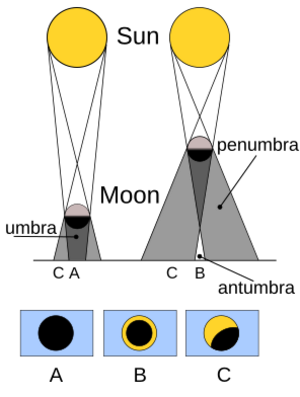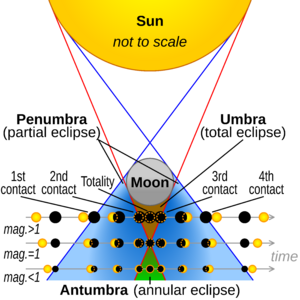Eclipse facts for kids
An eclipse is an amazing event in space. It happens when one object in the sky moves into the shadow of another. Think of it like one object blocking the light from another.
When an eclipse happens in a star system, like our Solar System, it means three or more objects are lined up almost perfectly. This special alignment is called a syzygy.
The word eclipse is most often used for two main events:
- A solar eclipse: This is when the Moon's shadow falls on Earth.
- A lunar eclipse: This is when the Moon moves into Earth's shadow.
A solar eclipse can't last longer than 7 minutes and 58 seconds. This is because of how fast the Earth and Moon move. If the Sun is not involved, the event is usually called an occultation.
Contents
What's in a Name?
The word "eclipse" comes from ancient Greek. It comes from the word ekleípō, which means "to stop being there" or "to disappear." This makes sense, as an eclipse makes something seem to disappear!
Shadow Parts: Umbra, Penumbra, and Antumbra
When one object blocks light from another, it creates a shadow. This shadow has three main parts:
- The umbra: This is the darkest, inner part of the shadow. If you are in the umbra, the light source (like the Sun) is completely blocked.
- The antumbra: This part is beyond the tip of the umbra. From here, the object blocking the light appears completely in front of the light source, but it's too small to cover it entirely.
- The penumbra: This is the lighter, outer part of the shadow. If you are in the penumbra, the light source is only partly blocked.
When you see an eclipse, the type you observe depends on which part of the shadow you are in:
- A total eclipse happens if you are in the umbra.
- An annular eclipse happens if you are in the antumbra.
- A partial eclipse happens if you are in the penumbra.
For a lunar eclipse, only the umbra and penumbra apply. This is because Earth's shadow is much bigger than the Moon.
Astronomers also talk about "contacts" during an eclipse:
- First contact: When the object starts to cover the light source.
- Second contact: When the object is fully inside the light source's disk.
- Third contact: When the object starts to move out.
- Fourth or last contact: When the object has completely left the light source.
The Earth's shadow moves very fast during an eclipse, about 1 kilometer per second!
Eclipse Cycles
An eclipse cycle is when eclipses happen in a repeating pattern over time. This is because the way planets and moons orbit creates regular patterns. One famous cycle is the saros. It means a solar or lunar eclipse will repeat every 6,585.3 days, which is a little over 18 years. Since it's not a whole number of days, each eclipse in a saros cycle will be seen from a different part of the world.
Eclipses with Earth and Moon
Eclipses involving the Sun, Earth, and Moon can only happen when they are almost in a straight line. This allows one to hide behind another when viewed from the third. The Moon's path around Earth is slightly tilted compared to Earth's path around the Sun. So, eclipses can only happen when the Moon is near the points where these two paths cross. These points are called nodes.
The Sun, Earth, and these nodes line up twice a year. This time is called an eclipse season. Eclipses can happen during a period of about two months around these times. There can be between four and seven eclipses in a calendar year.
Solar Eclipse

From Earth, a solar eclipse happens when the Moon passes directly in front of the Sun. The type of solar eclipse you see depends on how far the Moon is from Earth during the event.
- A total solar eclipse happens when Earth is in the Moon's umbra (the darkest part of its shadow). The Moon completely blocks the Sun.
- An annular eclipse happens when the Moon is too far from Earth to completely cover the Sun. You see a bright ring of sunlight around the Moon.
- Partial solar eclipses happen when you are in the Moon's penumbra (the lighter part of its shadow). The Moon only covers part of the Sun.
Solar eclipses are short events. A total solar eclipse can last up to 7 minutes and 31 seconds. The path where you can see a total eclipse is usually narrow, about 250 kilometers wide. However, a partial eclipse can be seen over a much larger area.
During a total solar eclipse, the Moon can perfectly cover the Sun. This is because, from Earth, the Moon and Sun appear to be almost the same size!
Did you know that other objects can also eclipse the Sun? For example, the crew of Apollo 12 saw the Earth eclipse the Sun in 1969. Also, the Cassini probe saw Saturn eclipse the Sun in 2006.
Lunar Eclipse

Lunar eclipses happen when the Moon moves through Earth's shadow. This can only occur during a full moon, when the Moon is on the opposite side of Earth from the Sun.
Unlike solar eclipses, a lunar eclipse can be seen from almost half of Earth! This makes them much more common to see from any given place. Lunar eclipses also last longer, often taking several hours from start to finish. The total part of the eclipse usually lasts from about 30 minutes to over an hour.
There are three types of lunar eclipses:
- Penumbral: The Moon passes only through Earth's penumbra (the lighter part of the shadow). This type is often hard to notice.
- Partial: The Moon goes partly into Earth's umbra (the darkest part of the shadow).
- Total: The Moon goes completely into Earth's umbra.
Even during a total lunar eclipse, the Moon doesn't become completely dark. Some sunlight bends through Earth's atmosphere and still reaches the Moon. Just like how sunsets look red, Earth's atmosphere scatters blue light more. This means the light that reaches the Moon is reddish. That's why a total lunar eclipse is sometimes called a 'Blood Moon'!
Historical Records
People have been recording solar eclipses for thousands of years! Ancient records, like a clay tablet from Syria, mention a solar eclipse in 1223 B.C. Chinese records of solar eclipses go back over 4,000 years. These records have even helped scientists understand changes in how fast Earth spins.
By the 1600s, astronomers in Europe were publishing books with drawings to explain how lunar and solar eclipses happened. This helped more people understand eclipses and reduced fear about them.
Eclipses on Other Planets
Gas Giants
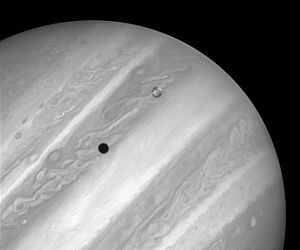
The gas giant planets (Jupiter, Saturn, Uranus, and Neptune) have many moons, so they often have eclipses. Jupiter is especially interesting because it has four large moons and its axis isn't very tilted. This means its moons frequently pass through Jupiter's shadow. You can often see the round shadows of these large moons moving across Jupiter's cloud tops!
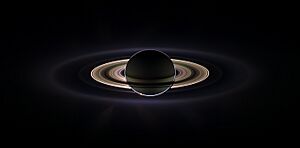
The eclipses of Jupiter's moons helped scientists make an important discovery. In the 1670s, it was noticed that these eclipses happened about 17 minutes later than expected when Jupiter was far from Earth. A scientist named Ole Rømer figured out that this delay was caused by the time it takes for light to travel from Jupiter to Earth. This led to the first estimate of the speed of light!
On the other gas giants, eclipses only happen at certain times during their long orbits. This is because their moons' paths are more tilted. For example, Saturn's moon Titan only crosses the line of sight to the Sun about every 15 years.
Mars
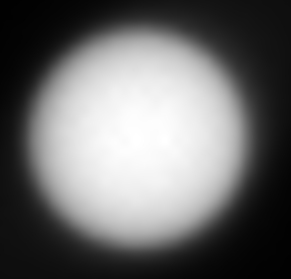
On Mars, only partial solar eclipses (called transits) are possible. This is because neither of Mars's moons is big enough to completely cover the Sun from the planet's surface. However, Mars's moons are often eclipsed by Mars itself, with hundreds of these events happening each Earth year. Sometimes, one Martian moon, Deimos, is even eclipsed by the other, Phobos! Rovers and orbiters have photographed these Martian eclipses.
Pluto
Pluto and its largest moon, Charon, also have many eclipses. A series of these mutual eclipses happened between 1985 and 1990. These daily events helped scientists accurately measure the size and other features of both Pluto and Charon for the first time.
Mercury and Venus
Eclipses are not possible on Mercury and Venus because they don't have any moons. However, both planets have been seen passing directly in front of the Sun. This is called a transit. Transits of Mercury happen about 13 times each century. Transits of Venus are much rarer, happening in pairs separated by eight years, but each pair occurs less than once a century. The next pair of Venus transits will be in 2117 and 2125.
Eclipsing Binary Stars
A binary star system is made of two stars that orbit around each other. When these stars' orbits are lined up with our view from Earth, one star can pass in front of the other. When this happens, the system becomes an eclipsing binary. This means its brightness changes regularly.
When one star passes in front of the other, the total brightness of the system goes down. It returns to normal once the stars are no longer blocking each other.
The first eclipsing binary star system ever found was Algol, which is in the constellation Perseus. Normally, Algol is quite bright. But every 2.867 days, its brightness drops for more than nine hours. This happens because a dimmer star in the pair passes in front of the brighter one. A scientist named John Goodricke figured this out in 1783.
Images for kids
-
Totality during the 1999 solar eclipse. You can see bright red Solar prominences and the beautiful corona (the Sun's outer atmosphere).
See also
 In Spanish: Eclipse para niños
In Spanish: Eclipse para niños



